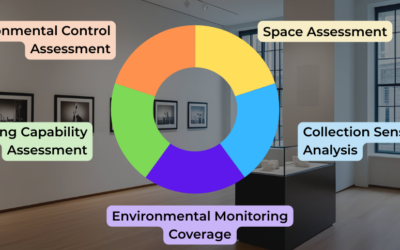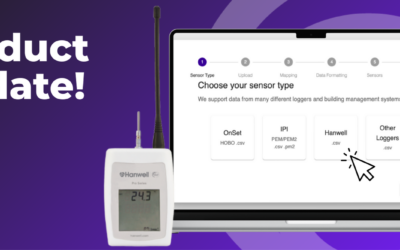What is IoT and what does this fancy-sounding technology thing have to do with museums?
IoT is short for the Internet of Things. This term relates to the interconnection of devices over the internet. Generally, these devices will have a sensor of some sort to measure or listen in to something and help you make a decision or complete an action by connecting to the internet. For example, being able to tell your phone to turn on the lights of your house at a certain time related to the sunset. Or having the fridge send you a notification that you’re running out of milk and actually allowing the phone to put in that order for you.
So what can the Internet of Things do for a museum?
An IoT based environment monitoring system can help museums by using sensors, devices, and cloud services to collect, process, and visualize environmental data in real time. Thanks to this real-time component, an IoT system can also alert museum staff of any abnormal or harmful conditions and enable them to take preventive or corrective actions. In this post, we will explore the benefits, components, and use cases of an IoT based environment monitoring system for museums.
Benefits of an IoT Based Environment Monitoring System for Museums
An IoT based environment monitoring system can provide several benefits for museums, such as:
- Improving the preservation of collections: By monitoring the environmental parameters in real-time that affect the deterioration of artifacts, such as temperature, humidity, light, dust, and pollutants, collections care professionals can maintain optimal conditions for their collections and reduce or even prevent damage caused by environmental factors.
- Enhancing the visitor experience: By ensuring an appropriate environment for visitors that aligns with collection needs, museums can improve their satisfaction and engagement. For example, museums can use smart lighting systems to create different effects and moods. Automatic shutters and electrochromatic glass can be leveraged to adjust light throughout the day.
- Reducing operational costs: By using IoT devices and cloud services, museums can automate and optimize their environmental management processes and reduce their energy consumption and maintenance costs. For example, museums can use smart thermostats to regulate the heating and cooling systems or use smart sensors to detect leaks or faults in the plumbing or electrical systems.
- Increasing operational efficiency: With IoT devices and cloud services, museums can access and analyze environmental data from anywhere and at any time, and make informed decisions based on real-time insights. For example, museums can use dashboards and reports to monitor the performance of their environmental systems or use predictive analytics to anticipate future needs and trends.
Components of an IoT Based Environment Monitoring System for Museums
An IoT based environment monitoring system for museums will consist of three main components.
- Sensors: Different sensors living inside data loggers will measure physical properties such as temperature, humidity, light, and movement. The data loggers can then be deployed in various locations within the museum premises, such as exhibition halls, storage rooms, corridors, entrances, exits, etc. The sensors inside your loggers can communicate wirelessly with other devices or cloud services using protocols such as Wi-Fi, Bluetooth, LoRaWAN, etc. Remember your measurements will only ever be as good as the quality of the sensor inside your equipment. As an example, check out the specifications of Conserv’s latest SCS-3 sensor.
- Devices: Devices are hardware components that process, store, or transmit data from sensors or cloud services. In the case of the Conserv system, you can think of your data loggers and your gateways as devices. Devices can be embedded in existing infrastructure or equipment (such as HVAC systems or lighting systems), or standalone (such as gateways or routers). In more advanced cases, devices can perform actions based on data or commands from sensors or cloud services (such as adjusting the temperature or turning on/off the lights).
- Cloud services: Cloud services, like Conserv Cloud, are software applications that run on remote servers and provide various functions such as data storage, data analysis, data visualization, data security, data sharing, etc. In some cases, cloud services can also integrate with other applications or platforms (such as Collections Management Systems or social media platforms) to provide additional features or functionalities.
Use Cases of an IoT Based Environment Monitoring System for Museums
An IoT based environment monitoring system for museums can be used for various purposes and scenarios, such as:
- Monitoring temperature and humidity: Temperature and relative humidity are two of the most important environmental parameters that affect the preservation of collections. Too high or too low temperature or humidity can cause physical or chemical changes in the materials of artifacts, such as cracking, warping, fading, corrosion, mold growth, etc. An IoT based environment monitoring system can help museums monitor the temperature and humidity levels in different zones within the museum premises (such as exhibition halls, storage rooms, etc.) and alert museum staff of any deviations from the optimal ranges. Museum staff can then adjust the HVAC systems accordingly or take other measures to restore the desired conditions.
- Monitoring light: Light is another important environmental parameter that affects the preservation of collections. Too much light can cause damage to artifacts such as paintings, photographs, textiles, etc., by fading, discoloring, or deteriorating their pigments, dyes, or fibers. On the contrary, too little light can make it impossible for visitors to appreciate an exhibition. An IoT based environment monitoring system can help museums monitor the light exposure of objects around the collections and allow museum staff to make decisions for increased exhibition or dark storage hours to protect the artifacts from excessive light exposure.
- Monitoring dust and pollutants: Dust and pollutants are another important environmental parameter that affects the preservation of collections. Particulate matter can accumulate on the surface of artifacts and cause damage such as abrasion and increased humidity microclimates which can lead to mold growth and staining. It is possible to have particulate matter sensors that measure air quality by measuring the scattered light of a laser beam inside it. While this is not something that Conserv offers at the moment, it would not be impossible to consider it in the future thanks to LoRaWAN technology.
- Monitoring movement: Did your data logger fall off a shelf? Did someone take it to a different location and forgot to tell you? Keeping track of your devices is key to making sure you are getting the correct information for the location you expect. A real-time alert on an IoT movement sensor would be able to tell you if either of these events occur and allow you to take action before you start making all the wrong conclusions about your environment in a particular space.
Conclusions
In 2023, it would be a shame not to take advantage of the latest technology and harness the internet to improve the ways in which you can make decisions for collections care in a museum setting. An IoT based environment monitoring system for museums is a powerful tool that can help heritage institutions improve their environmental management and conservation practices, enhance visitor experience, reduce operational costs, and increase their operational efficiency.
By using sensors, devices, and cloud services, both facilities and collections staff in museums can collaboratively collect, process, and visualize environmental data in real time, and take actions based on real-time insights. An IoT based environment monitoring system for museums can also help you achieve your sustainability goals and contribute to the global efforts to protect the environment.
If you would like to see what an IoT system looks like in real life, reach out to us. If you just want to see how the platform works with your own logger data, Conserv Cloud will allow you to upload imported .csv files that you can then graph and analyze. This will not take the best advantage of the IoT capabilities, but you will be able to play around with the platform and see how you like it.
If you have any questions about environmental monitoring, integrated pest management, or just want to talk about preventative conservation, please reach out to us! Don’t forget to check out our blog or join our community of collections care professionals where you can discuss hot topics, connect with your peers or even take a course to get familiar with the Conserv platform.




